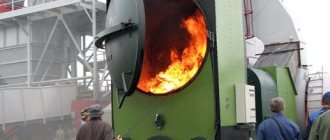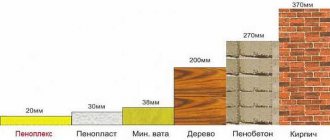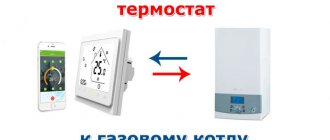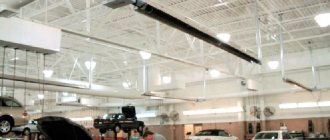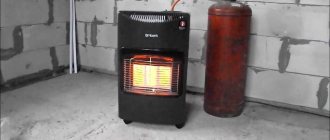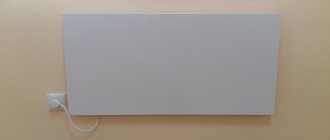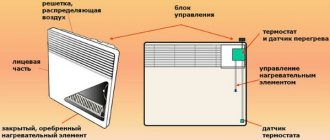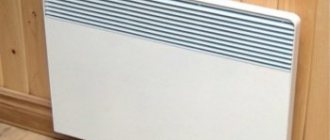Russia is a country with different climatic zones, which is no stranger to severe frosts and long winters. And it’s no wonder that sometimes, in addition to centralized heating, additional heating equipment is used, and in particular, heaters. Among the latter, there are even Soviet models that continue to function, the safety of operation in modern conditions of which will be discussed.
Principle of operation
An oil heater consists of a metal body that visually resembles a stationary battery, special mineral oil and a heating element.
After turning on the device, the heating element begins to work, heating the oil to the desired temperature. Next, the oil transfers its heat to the metal shell, which gradually heats the surrounding air.
All modern models have several operating modes, thanks to which you can choose the intensity of heating the air in the room.
The built-in timer helps regulate the temperature: when the air is heated at a given temperature, the device turns off, and when it gets cold, it turns on.
Electronic convector
The device has a thin body in a suspended or floor-standing version. The heater emits thermal waves only from the front panel, and heats the air by thermal exchange of circulating air masses along the body. The convector works by heating the heating element located in the convection chamber and does not come into contact with the body. The temperature is controlled by a thermostat that turns the heater off and on.
The convector has the following advantages:
- the device is fireproof because it meets the relevant requirements of the European standard;
- heater modules, installed in any room and connected into a common network, allow you to get modular heating, similar to the installation of a boiler, but significantly cheaper in price and installation;
- the highest efficiency due to the absence of intermediary materials;
- allows you to save energy due to the electric thermostat and various operating modes;
- longer service life, reaching 10-15 years;
The electronic convector has the following disadvantages:
- is not able to adequately heat rooms with high ceilings, because all the warm air will accumulate in the highest part of the room;
To solve the problem of uniform heating of the air, we recommend paying attention to convectors built into the floor: https://gidpopechkam.ru/obogrevateli/konvektory-otopleniya-vodyanye.html
- real heating of the room is possible only with additional equipment of the artificial ventilation system;
- heated air moves dust as it moves.
Most manufacturers equip the convector with a heating element consisting of a special material, the temperature of which is controlled by sensors, and does not reach the threshold value at which oxygen begins to burn out and dust particles begin to burn.
Types and characteristics of oil heaters
All radiators operate according to the same algorithm, but differ in the set of additional functions, type of mounting and price. Depending on the goals set for the device and its location, oil radiators are divided into:
- Wall-mounted – economical in terms of electricity consumption.
- Floor-standing ones are popular because of their mobility.
- Tabletop - low level of heat transfer.
- For cots.
- Ceiling.
Some models are equipped with a fan that disperses flows of warm heated air throughout the room. The disadvantage of such a device is noise during operation. The developers of some companies have included a humidifier in their models.
This device is especially relevant in the cold season, when the air outside becomes much drier, and the heater itself gradually dries it out further. Some units have a delayed start function.
Before using the device, read the instructions
As for more detailed information on using the device, you should look for it in the instructions for the specific model. Each manufacturer sets its own requirements (in accordance with the characteristics of the equipment, its type) for the operation of the convector. Compliance with them allows you to increase the operating time of the heater, as well as avoid the need for regular repairs.
Each heater presented in KSK TRADE is accompanied by a detailed user manual, which will simplify your operation of the device and make it as convenient, safe, and long-lasting as possible.
Advantages of oil heaters
- High level of device security. In an oil radiator, all heating elements are hidden inside, and the outer shell heats up to a temperature of no more than 60 degrees.
This eliminates the possibility of a fire due to a fall or burns to the skin surface due to tactile contact. The last factor is important in families with small children.
- Long service life. The device is designed in such a way that the components do not burn out due to long continuous operation. The device can work without turning off for up to three days.
- The compact size of the device and its mobility allow you to move it to different parts of the house or apartment. And quiet operation will not cause any discomfort.
- The price of oil radiators is affordable. The cost depends on the number of sections that the device has.
- No foreign odors are emitted during operation of the device. Radiators do not dry out the air in the room, which means that you do not have to spend extra money on purchasing a humidifier.
- To install such a heater, you do not need special knowledge or tools. You simply plug in the device and enjoy the warmth.
How long will electronic heaters last? Their reliability
The main thing when buying equipment is to first solve the problem of how to create it very profitably: save on installation, electricity, equipment costs and ensure reliability and durability. We offer some tips and facts for thought.
The thermal curtain has an estimated service life of 25 years and it is better if it has spiral heating. The curtain with the heating element will fail faster. The fan heater is ready to operate for approximately 4 years.
If you compare oil radiators and electric convectors, it is more profitable to take the 2nd option. It will work for about 15 years (a longer period), because its system is simpler. The convector also works longer when switched on than the radiator. And he, in turn, will be in work for 5-7 years, but these are approximate numbers (average period). Radiators stop working when the density of their casing is compromised.
Infrared heaters operate for about 25 years without maintenance. They are suitable as main heating or additional heating.
Electric heaters come in different types according to their operating mechanism:
The question of how long electric heaters will last is difficult to answer. Everything depends not only on the warranty period, but also on the type of device, its features, and the method of caring for it.
The service life of electric heaters depends primarily on the care of the owner.
Do you want your heater to last for a long time? But don't really look for advice? Equipment in such conditions will not last long! You need to take care of your dress from a young age. If it has already been repaired once, then the equipment will continue to break down, and the overall service life will decrease. Homemade heaters are completely prohibited.
Do you understand the secret to extending the life of any type of electric heater? Not 4 years, but 14, not 15, but 25 years! You just need to take proper care!
Methods for increasing the service life of electric heaters
If it is necessary to extend the service life of electric heating, the following rules should be followed:
- Pay special attention to the advice described in the annotation, heard from the master. The type of heater determines the method of caring for it, and hence the period of use.
- This is not a toy for children, so access should be limited.
- Drying things on equipment is prohibited (unless there are special devices).
- The device should be installed away from flammable objects, such as curtains.
- In a building that is under renovation, the heater can only be turned on away from paints and varnishes.
- It is necessary to inspect for debris inside.
- Ensure minimal power fluctuations.
- If repair of electric heaters is required, take it to reliable services.
When choosing electric heating in the Teplodar store, you will certainly find something that is suitable for you in terms of service life and quality. The company’s specialists will tell you about all the details of this issue and help you choose a Venice heater to suit your personal requirements. Buy and enjoy the warmth and comfort!
Source: domateplo.com.ua
Disadvantages of oil heaters
An oil cooler has several negative aspects that you need to be aware of before purchasing. They are quite controversial and can be easily eliminated:
- Heavy radiator weight. It will not cause any difficulties when moving, since each model is equipped with wheels, and there is no need to lift the unit at all.
- Long room heating time. First, the heating element inside the device heats the oil, and only after that does it heat the outer shell of the radiator.
But this drawback can be easily eliminated if you initially purchase a radiator with a built-in fan, which will disperse warm air around the room, thus heating it up faster.
general information
The design and operating mechanism of all oil radiators are similar. The differences are only in power, equipment (degree of automation), dimensions and design of the case. A heating device of this class is a sealed metal tank, approximately 80% filled with mineral oil.
A heating element is located at the bottom of the radiator; in some models there are 2, or even 3. When the oil is heated, convective liquid flows (rushing upward) moderately distribute heat over the entire size. Next - into the environment.
How to choose an oil heater
Consider simple rules:
- Heater power. To heat 10 square meters of area you need about 1 kW of power. The manufacturer does not produce radiators with a power exceeding 3 kW. To heat larger rooms, you will need several copies.
- Size. The number of sections ranges from 5 to 14. The more sections in the radiator, the faster it will heat the room and the more electricity it will consume.
- Model design . When purchasing, pay attention to the presence of a light indicator, temperature controller and several operating modes. There should also be protection against overheating of the device, which will protect you from unforeseen situations.
With several modes, you can independently regulate the temperature that the device produces, and thus save the energy it consumes.
- Timer , with which you program the radiator to turn on or off for a certain time.
- Built-in air humidifier . During the cold season, the air becomes dry, which negatively affects the skin. The built-in air humidifier operates while the heater itself is operating, bringing the humidity in the room back to normal.
- Built-in fan. It will speed up the process of heating the room, but models with this function are much more expensive.
Also pay attention to the following aspects:
- Give preference to radiators with narrow sections. They heat up faster and transfer heat to the room. When reducing the size of sections, increase their number.
- Large sections take a long time to heat up and cool down, this provides additional heat, but requires additional electricity costs.
- If the device is lightweight, but at the same time large in size, it means that the manufacturer has saved on materials.
- Radiators of dark color give off heat better.
Convector heaters
At the first glance at heaters of this type, their flat and even body shape catches your eye.
Most often, such heaters are supposed to be attached to the surface of the walls, but there are also floor-mounted options. Moreover, the latter are equipped with swivel wheels for ease of movement around the room. Some models can be either wall-mounted or floor-mounted. The so-called plinth convectors look interesting; they have a very small height (from 15 cm), but their length can reach up to 1.5 meters.
The required temperature level in the room is maintained using a thermostat. Unlike the considered oil appliances that emit heat, convectors heat the room by moving air flows of warm and cold air. There are holes in the lower and upper parts of the convector body. Having heated up from the heater, warm air is discharged out through holes in the upper part of the case, and instead of it, a new portion of cool air arrives from below. Thus, due to constant air circulation, the rooms are heated. At the same time, the operation of convectors is almost silent, and the room heats up quite quickly.
A convector mounted on the wall takes up virtually no space in the room and does not interfere with movement around it, which is especially important if there are small children in the family. In addition to options for the home, you can find convector heaters for offices and industrial premises on sale.
Which is better
Before purchasing a radiator, you should calculate how much area it will need to heat. The heating function depends on the power of the radiator and the number of sections.
The power is selected depending on the size of the room in which the radiator will operate: for 10 square meters of room you need 1 kW of generated electricity.
The formula applies to rooms where the ceiling height is no more than 2.75 m. If the ceilings are located higher, the required power can be calculated using the following algorithm:
- Multiply the length of the room by the width to get the area.
- Multiply the resulting number by the height of the room, this way you will get the required volume.
- Divide the resulting figure by 25, because 1 kW of energy per 25 m3 is calculated. The result obtained is the power needed to heat the room.
Then it’s a matter of individual taste and financial capabilities. A simple oil heater has a standard set of functions and is inexpensive.
Models equipped with fans, timers, humidifiers and remote controls are more expensive, but more comfortable to use.
Exploitation
Precautionary measures:
- Before you start using the device, make sure that the voltage in the apartment outlet corresponds to that recommended by the manufacturers.
- If you are not using the device, unplug it from the outlet.
- Do not leave the device on when there is no one in the room.
- Do not cover the device with clothing, this will cause overheating or a fire. It is better to place it at a safe distance from flammable substances.
- Keep the device clean.
- In the event of a breakdown, do not try to disassemble the radiator parts yourself; it is better to leave this work to professionals.
- Supervise children closely if they are in the same room as the device is in use. Do not allow them to play with the cord or appliance, as this may result in short circuit, electric shock or fire.
- Carefully monitor the condition of the device itself, the wire and the plug. Do not use the heater if the cord or plug is damaged.
- The device is intended exclusively for indoor home use.
Preparing for work
If the device was purchased in the cold season, then it must be carefully unpacked, placed on wheels and left for at least 3 hours.
After this, plug the radiator into a grounded outlet and leave it to work for 1 hour in a ventilated area. This will evaporate all foreign odors that may appear at the initial stage.
Oil Cooler Maintenance
Oil heaters do not require special maintenance during their service life, unless there are any complaints or complaints.
- If you need to store the device for a long time, wipe it with a slightly damp cloth to remove dust and dirt, disconnect the cord, and roll it up carefully. Remove the support wheels and put them in a box, which you close tightly.
- When you need the heater again, take it out of the box, wipe it off again from dust, and reassemble it. Carefully inspect the device for any deformation or oil leakage.
Oil cooler disposal
When the oil heater becomes unusable, it must be disposed of according to the following scheme:
- Cut off the power cord from the unit.
- Drain the oil, which is dangerous for humans, and hand it over to a special collection point.
- The body can be sold for scrap.
Guarantee
The warranty period for storage of oil radiators is 1 year, and for use - 2 years.
During the warranty period, the manufacturer guarantees satisfaction of the buyer's requirements related to problems in the operation of the radiator, subject to the rules of operation, transportation and storage of the device.
Why an oil cooler is unsafe
Heating devices of this group for us are characterized by a lot of advantages, which explains their demand. But if you look at the correspondence on forums aimed at a specific topic, then one of the main concerns that worries users is the safety of the products. Judgments on this issue are different, including some very bad ones, right up to advice to abandon the use of oil radiators in the house. Are they really so unsafe and are all skeptical assessments justified?
Malfunctions
The most common problems with oil radiators are:
- A cracking noise is heard when turned on and during the first 10-15 minutes of operation. If after this time the cracking disappears, it’s okay. It occurs when the oil inside the radiator heats up.
Perhaps drops of water got into it, which causes such a reaction. This is possible if the device was assembled in conditions of high humidity.
- The radiator does not turn on. First, carefully inspect the cord and plug for cracks or creases. If they are not found, try plugging the heater into a different outlet.
If this does not work, then the problem is in the contact, which has come loose. Try to repair the device yourself or send it to a service center, where experienced technicians will solve the problem.
- The device turns on, but does not heat up. At the same time, indicator lights, a fan and other additional devices on the case work.
The cause of such a breakdown is problems with the thermal relay; it cannot be eliminated without special tools. Contact the service center.
- Oil is leaking. Such a breakdown occurs due to a manufacturing defect (poorly sealed seam) or a long period of use of the device.
Over time, the metal at the joints burns out and becomes thinner, which leads to this type of failure. Unfortunately, it is impossible to repair an oil leak either independently or at a service center.
If the breakdown is serious, you should carefully consider the prospect of buying a new radiator, because sometimes repairs cost more than a new device.
Manufacturers of oil heaters
Ballu
The company is known for high-quality products with a matte textured coating, which increases heat transfer by 20%. The products are coated with an anti-corrosion compound, which prevents the device from rusting.
The new generation thermostat closely monitors the room temperature. Among the distinctive features, it is necessary to highlight the special design of the legs, which make it impossible for the heater to fall.
De'Longhi
The advantages are absolute noiselessness when the heaters operate, uniform heating of the rooms and the absence of open heating elements that can cause burns.
The combination of efficiency, functionality and quality makes the heaters of this company in demand.
Oasis
The main direction is the production of high-quality heating equipment, among which a special place is occupied by oil radiators of various types: cast aluminum, steel, panel and bimetallic radiators.
Recahta
A Russian brand that has won a large number of fans in a short time.
The company is constantly moving forward, making oil radiators more and more advanced and of higher quality, providing them with a large number of additional features.
Scarlett
The company does not specialize exclusively in heaters, but has a wide selection of products for the home.
Sinbo
The company has been in the heating equipment market for more than 30 years, but does not have a huge number of oil radiator models.
Among 5 models that differ in appearance, power and number of sections, everyone can choose the option that suits them perfectly.
Supra
The company constantly pleases its customers with an updated range of oil radiators. The models of the new line have heaters with a large list of additional functions.
Electronic convector
The device has a thin body in a suspended or floor-standing version. The heater emits thermal waves only from the front panel, and heats the air by thermal exchange of circulating air masses along the body. The convector works by heating the heating element located in the convection chamber and does not come into contact with the body. The temperature is controlled by a thermostat that turns the heater off and on.
The convector has the following advantages:
- the device is fireproof because it meets the relevant requirements of the European standard;
- heater modules, installed in any room and connected into a common network, allow you to get modular heating, similar to the installation of a boiler, but significantly cheaper in price and installation;
- the highest efficiency due to the absence of intermediary materials;
- allows you to save energy due to the electric thermostat and various operating modes;
- longer service life, reaching 10-15 years;
The electronic convector has the following disadvantages:
- is not able to adequately heat rooms with high ceilings, because all the warm air will accumulate in the highest part of the room;
To solve the problem of uniform heating of the air, we recommend paying attention to convectors built into the floor: https://gidpopechkam.ru/obogrevateli/konvektory-otopleniya-vodyanye.html
- real heating of the room is possible only with additional equipment of the artificial ventilation system;
- heated air moves dust as it moves.
Most manufacturers equip the convector with a heating element consisting of a special material, the temperature of which is controlled by sensors, and does not reach the threshold value at which oxygen begins to burn out and dust particles begin to burn.
